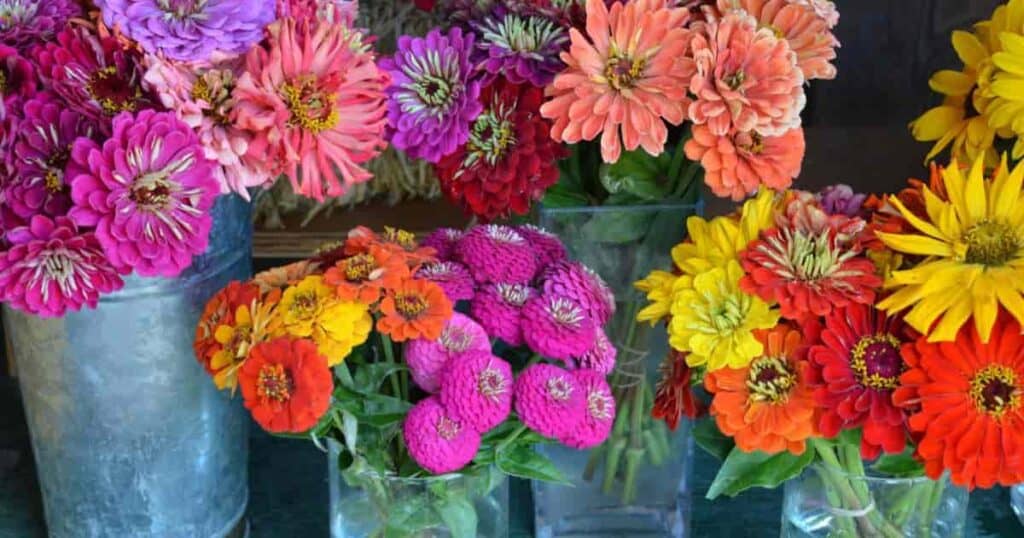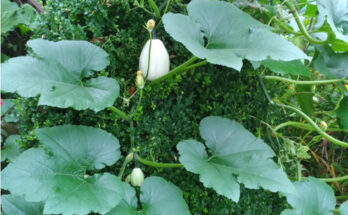There are many wonderful options for your garden, but two of the more popular ones are zinnias and dahlias. These two plants have a lot in common, making it sometimes difficult to decide which to plant.
It doesn’t help that you might have spotted nearly identical blooms. Yet, these two plants are different, and it’s important to choose wisely based on your own needs.
What Is The Difference Between Zinnia and Dahlia?
Despite many similarities, there are also some notable differences between dahlias and zinnias.
Here are some of the most notable differences between the two.
Botanical Lineage
One of the reasons dahlias and zinnias seem so similar is that they’re close relatives.
Both come from the Asteraceae family and Asteroideae subfamily. But dahlias are from the Coreopsideae tribe, while zinnias are from the Heliantheae tribe.
Additionally, there are 42 dahlia species and 22 zinnia species, plus countless hybrids and cultivars of both genera.
Blooms
This is where things get truly crazy!
Both zinnias and dahlias can look quite similar, yet each genus has a variety of bloom shapes, sizes, and colors to set them apart.
Add in all the cultivars (more than 57,000 registered dahlia cultivars alone!), and things get complicated fast!
Let’s take a brief look at some of these bloom differences.
Zinnias
Zinnias tend to have a distinctive central disk and blooms that range from 1″ to 6″ inches across.
The petals can be either solid or variegated, coming in the following shades:
- Chartreuse
- Cream
- Gold
- Lilac
- Orange
- Pink
- Purple
- Red
- White
- Yellow
In most cases, the petals exist in a single layer (similar to daisies), semi-double, or double. But some varieties more closely resemble marigolds in shape.
Dahlias
And now we get to the true monster, with a central disk that’s usually not visible.
Their default colors are:
- Orange
- Pink
- Purple
- Red
- Yellow
Still, several more colors are available via cultivars. Coloration ranges between solid, spotted, striped, or other types of variegation.
Flower Shapes
As for flower shapes and sizes, there’s a massive range with blooms measuring from 2″ inches to over 1′ foot across!
The National Dahlia Society and Royal Horticultural Society both recognize 14 different shape categories:
- Group 1: Single-Flowered Dahlias – central disk with a single outer ring of ray florets that may or may not overlap
- Group 2: Anemone-Flowered Dahlias – one or more rings of flat ray florets surrounding a dense group of tubular florets and no disc
- Group 3: Collerette Dahlias – a single-flowered dahlia, but with a small inner “collar” of ray florets surrounding the central disc
- Group 4: Waterlily Dahlias – double blooms with slightly curved ray florets and a depth that is less than ½ the diameter
- Group 5: Decorative Dahlias – double-blooms with no central disc and ray florets that are slightly twisted or involute for no more than 75% percent of their length
- Group 6: Ball Dahlias – double blooms, round but flattened somewhat with ray florets involute for at least 75% percent of their length
- Group 7: Pompon Dahlias – fully double spherical blooms of miniature florets that are involute
- Group 8: Cactus Dahlias – fully double flowers with pointed ray florets revolute for at least 65% percent of their length
- Group 9: Semi-Cactus Dahlias – fully double blooms with ray florets that are revolute between 25% and 65% percent of their length
- Group 10: Miscellaneous Dahlias – dahlias that don’t fit into any other group, including some actual species
- Group 11: Fimbriated Dahlias – ray florets split or notched into two or more divisions uniformly throughout the bloom, giving it a fringed effect
- Group 12: Star Dahlias – single ring of ray florets that are uniformly either involute or revolute and surround a central disc
- Group 13: Double Orchid Dahlias – fully double blooms with no disc, a triangular center, and narrow, lance-shaped florets that are either involute or revolute
- Group 14: Peony-Flowered Dahlias – multiple rings of irregularly-arranged ray florets around a central disc
Height
Height is another big difference, with zinnias ranging from a mere 4″ inches to 3.5′ feet tall.
Dahlias are much taller, ranging from 1′ to 9′ feet tall, with the taller varieties often needing support.
Zinnias hold one height record over dahlias if you include elevation. Samples of the zinnia genus have been successfully grown on the International Space Station!
Lifespans
Both flower types seem to come back yearly, but only one is a perennial.
Dahlias die back every year, only to return due to their tuberous roots. Meanwhile, zinnias are annuals and only appear to return yearly because they’re efficient self-seeders.
Root Structure and Propagation
Speaking of tubers, this is another crucial difference between dahlias and zinnias.
Zinnias have a regular root system, while dahlias have tuberous roots. This difference also affects propagation methods.
Both plants can propagate through seeds, but only dahlias can divide to create more plants.
Zones
Finally, these two have very different ranges of USDA hardiness zones.
Dahlias have a pretty small range despite the best efforts of cultivators. They generally only grow in USDA hardiness zones 8 to 10.
Zinnias, meanwhile, are quite hardy and can tolerate zones 2 to 11.
This makes them perfect for almost any country garden, and many species can even be grown indoors.
Source link
Originally posted 2022-12-12 21:06:18.






